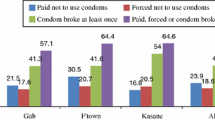Abstract
Based on a cross-sectional survey with 1,022 female sex workers (FSWs) recruited from different types of commercial sex venues in Southwest China, we examined their Internet-using behaviors and explored the feasibility of Internet-based HIV/STI intervention in this population. About 75% of FSWs were Internet users; among them 57% were frequent users, and 40% had searched HIV/STI information online. Internet use was significantly associated with younger age, more schooling, higher income, and engagement in a social network of Internet users. Frequent use of the Internet was associated only with factors of the social environment, such as peers’ Internet use. Two thirds of Internet-using FSWs were willing to participate in an online HIV/STI prevention program. Multivariate analyses showed that willingness to participate in an online HIV/STI prevention intervention was significantly associated with higher Internet use and younger age. Our data suggest that Internet may offer a promising strategy to deliver low-cost HIV/STI prevention programs for FSWs in China.
Similar content being viewed by others
References
Bennett GG, Glasgow RE. The delivery of public health interventions via the Internet: actualizing their potential. Annu Rev Public Health. 2009;30:273–92.
Swendeman D, Rotheram-Borus MJ. Innovation in sexually transmitted disease and HIV prevention: internet and mobile phone delivery vehicles for global diffusion. Curr Opin Psychiatry. 2010;23(2):139–44.
Pequegnat W, Rosser BR, Bowen AM, et al. Conducting Internet based HIV/STD prevention survey research: considerations in design and evaluation. AIDS Behav. 2007;11:505–21.
Noar SM, Black HG, Pierce LB. Efficacy of computer technology-based HIV prevention interventions: a meta-analysis. AIDS. 2009;23:107–15.
Ybarra ML, Bull SS. Current trends in Internet- and cell phone-based HIV prevention and intervention programs. Curr HIV/AIDS Rep. 2007;4:201–7.
Rietmeijer CA, McFarlane M. STI prevention services online: moving beyond the proof of concept. Sex Transm Dis. 2008;35:770–1.
Lou CH, Zhao Q, Gao ES, Shah IH. Can the Internet be used effectively to provide sex education to young people in China? J Adolesc Health. 2006;39(5):720–8.
Halpern CT, Mitchell EM, Farhat T, Bardsley P. Effectiveness of web-based education on Kenyan and Brazilian adolescents’ knowledge about HIV/AIDS, abortion law, and emergency contraception: findings from TeenWeb. Soc Sci Med. 2008;67:628–37.
China Ministry of Health, WHO. Joint report on HIV/AIDS Epidemic Update in China 2005-2007. Beijing: China Ministry of Health; 2007.
China Ministry of Health, UNAIDS, WHO. Update on the HIV/STD Epidemic and Response in China 2005. Beijing: China Ministry of Health; 2006.
Yang H, Li X, Stanton B, Liu H, Liu H, Wang N, et al. Heterosexual transmission of HIV in China: a systematic review of behavioral studies in the past two decades. Sex Transm Dis. 2005;32(5):270–80.
Liao SS, He Q, Choi K, et al. Working to prevent HIV/STDs among women in the sex industry in a rural town of Hainan, China. AIDS Behav. 2006;10(suppl):S35–45.
Hong Y, Li X. Behavioral studies of female sex workers in China: a literature review and recommendation for future research. AIDS Behav. 2008;12(4):623–36.
Huang Y, Henderson GE, Pan S, Cohen MS. HIV/AIDS risk among brothel-based female sex workers in China: assessing the terms, content, and knowledge of sex work. Sex Transm Dis. 2004;31:695–700.
Hong Y, Li X, Yang H, Fang X, Zhao R. HIV/AIDS-related risks and migratory status among female sex workers in a rural Chinese county. AIDS Care. 2009;21:212–20.
Hong Y, Li X. HIV/AIDS behavioral interventions in China: a literature review and recommendation for future research. AIDS Behav. 2009;13(3):603–13.
China Internet Network Information Center. The 23rd report on China Internet use and development. http://www.cnnic.cn/index/0E/00/11/index.htm. Accessed 5 April 2010.
Guo L. (2007). Survey report on Internet usage and impact in seven Chinese cities, November 2007, China Academy of Social Sciences. http://www.markle.org/downloadable_assets/china_internet_survey_11.2007.pdf. Accessed 5 April 2010.
Guangxi Center for Disease Control and Prevention. Update on HIV/AIDS epidemic in Guangxi. In: Presented at workshop of NIAAA venue-based HIV and alcohol risk reduction among female sex workers in China, 19–21 July 2009, Guilin, Guangxi.
China Statistics Press. China statistics year book 2008. http://www.stats.gov.cn/tjsj/ndsj/2008/left_.htm. Accessed 6 April 2010.
Li X, Wang B, Fang X, et al. Short-term effect of a cultural adaptation of voluntary counseling and testing among female sex workers in China: a quasi-experimental trial. AIDS Educ Prev. 2006;18(5):406–19.
Kok G, Harterink P, Vriens P, et al. The gay cruise: developing a theory- and evidenced-based Internet HIV-prevention intervention. Sex Res Social Policy. 2006;3:52–67.
Wynn LL, Foster AM, Trussell J. Can I get pregnant from oral sex? Sexual health misconceptions in e-mails to a reproductive health website. Contraception. 2009;79(2):91–7.
Moskowitz DA, Melton D, Owczarzak J. PowerON: the use of instant message counseling and the Internet to facilitate HIV/STD education and prevention. Patient Educ Couns. 2009;77(1):20–6.
Temesgen Z, Knappe-Langworthy JE, St. Marie MM, et al. Comprehensive Health Enhancement Support System (CHESS) for people with HIV infection. AIDS Behav. 2006;10:35–40.
Rogers SJ, Ying L, Xin YT, Fung K, Kaufman J. Reaching and identifying the STD/HIV risk of sex workers in Beijing. AIDS Educ Prev. 2002;14:217–27.
Lau JT, Tsui HY, Siah PC, Zhang KL. A study on female sex workers in southern China (Shenzhen): HIV-related knowledge, condom use and STD history. AIDS Care. 2002;14:219–33.
Yang X, Xia G, Li X, Latkin C, Celentano D. Social influence and individual risk factors of HIV unsafe sex among female entertainment workers in China. AIDS Educ Prev. 2010;22:69–86.
Internet World Stats. World Internet users and population stats. http://www.internetworldstats.com/stats.htm. Accessed 6 April 2010.
Acknowledgments
The study was supported “in part” by NIH Research Grant R01AA018090 by the National Institute for Alcohol Abuse and Alcoholism (NIAAA). The content is solely the responsibility of the authors and does not necessarily represent the official views of the NIAAA/NIH.
Author information
Authors and Affiliations
Corresponding author
Rights and permissions
About this article
Cite this article
Hong, Y., Li, X., Fang, X. et al. Internet Use Among Female Sex Workers in China: Implications for HIV/STI Prevention. AIDS Behav 15, 273–282 (2011). https://doi.org/10.1007/s10461-010-9846-1
Published:
Issue Date:
DOI: https://doi.org/10.1007/s10461-010-9846-1



